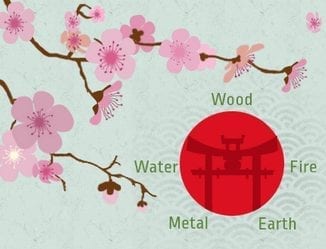The Five Element Theory serves as a major diagnostic and treatment tool in Traditional Chinese Medicine. It is based on the observation of the natural cycles and interrelationships in the environment and within ourselves. For example, there are five environmental elements – fire, earth, metal, water and wood – each corresponding with certain body organs, such as the heart, spleen, lungs, kidneys, liver, intestines, stomach, urinary bladder and gallbladder. The five different elements are associated with different times of the year: fire with summer, Earth with late summer, metal with autumn, water with winter and wood with spring.
The five elements interact with each other (they depend on each other). For example, the liver, belonging to the Wood element, directly affects the spleen, which belongs to the Earth element. Traditional Chinese Medicine (TCM) practitioners try to maintain a balance among the body’s organs.
Spring and the Wood Element
Spring is associated with the Wood element, which governs the liver and gallbladder. Strong winds are typical during spring. The blowing of wind in spring could over-strengthen the liver, which in turn could affect the spleen. If so, a disharmony of the liver and spleen occurs. TCM practitioners may detect this imbalance by observing symptoms such as stomach pain, acid regurgitation, stomach distention and diarrhea.
Addressing Springtime Health Issues with TCM
Allergy problems are abundant during spring. If the liver is not healthy, it could affect the spleen and the lungs. Symptoms of this disharmony between organs include: chest congestion, sneezing, running nose, itching eyes and other symptoms that are associated with allergy problems. It is very important, especially during spring, to cleanse the liver and lungs and to bring a balance among them and other body organs. Acupuncture and Chinese herbal medicine can help to accomplish this balance.
If you think a career in holistic medicine is something you would like to pursue, contact us and speak to an admissions representative to get started on your new journey!
If you think a career in holistic medicine is something you would like to pursue, contact us and speak to an admissions representative to get started on your new journey!
Seasonal Influence on Health According to TCM
TCM practitioners pay attention to weather, especially very extreme weather, like an unusually windy spring. Extreme or unusual weather can cause health imbalances in people. Health problems tend to occur during or immediately following certain seasons. The liver, which is said to “open into the eyes” in TCM, is associated with cases of infectious hepatitis and cases of pink eye, which tend to be more numerous in the spring.
Diet and Nutrition in Spring for Liver Health
TCM practitioners believe that a person should cater his or her diet to the seasons. Because spring is associated with the liver, it is important to have a diet that strengthens and cleanses the liver. There are many foods serving the purpose of soothing and cleansing the liver. Green is the color of the liver and of spring. Green and leafy vegetables, especially if the plants are young, help by cleansing and freshening the body. They benefit the liver’s overall well-being. Dandelion also works well as a spring cleanser. A balanced diet with a variety of juices such as citrus fruits, pear, apple, celery and carrot is very helpful. Sprouts from seeds such as beans, mung, and radish are valuable for spring use, as well.
Featured Posts:

